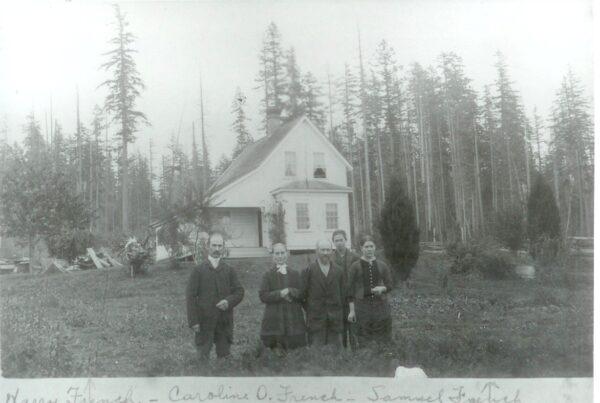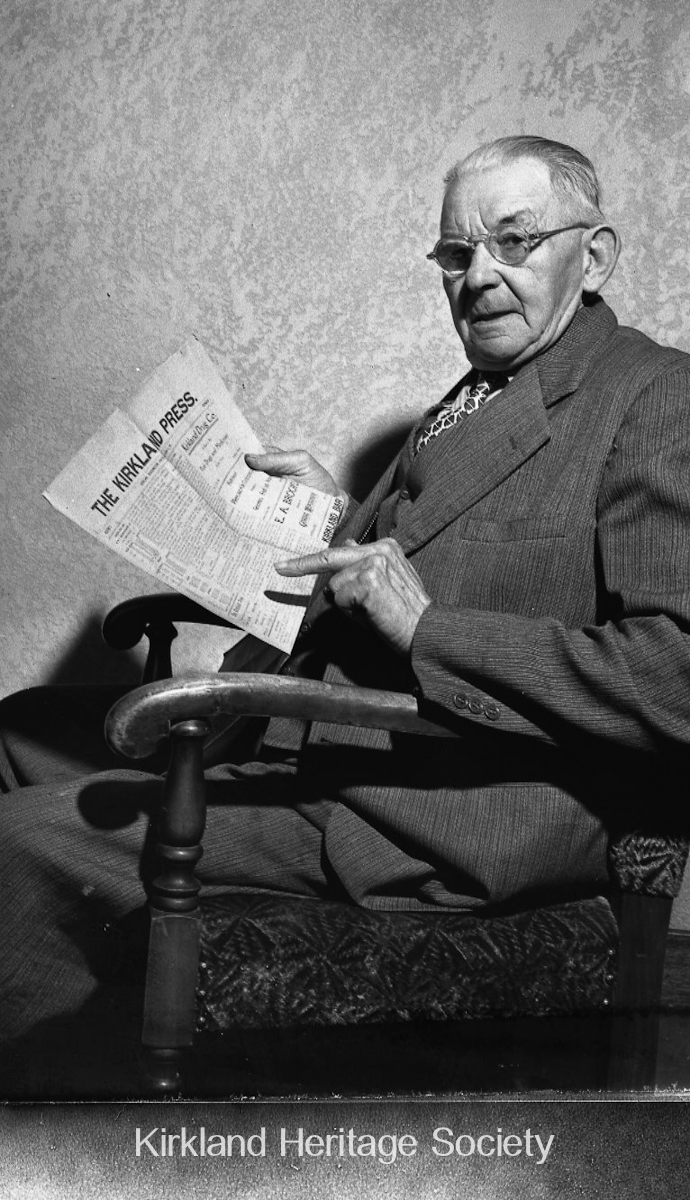The name, Cedarmere, conjures up a vision of beauty with emphasis upon cedar trees. However, Cedarmere’s fame, if such it may claim, is based upon a stalwart beech tree. This beautiful tree, imported from Denmark because of a woman’s longing to see a part of her homeland, stands as a giant sentinel close to the home of Mr. and Mrs. J. A. McCrory. It is unique in its unfoldment in that the first leaves are so deeply purple that they are nearly black, hence the tree is sometimes called the black beech. All summer long the leaves are reddish purple, so it is often called the purple beech. But in the fall, the leaves turn a coppery color and, for that reason, many call it the copper beech.
Mrs. Myrtle C. Robertson became interested in the Beech Tree Story and in 1944 uncovered a rare bit of Kirkland history when talking with Mrs. Walter Wittenmeyer She. in turn, referred her to Mrs. A. B. Newell for particulars and Mrs. Newe11 asked Mrs. Robertson to get in touch with Margaret W. Bayne from whom she had first leard the Beech Tree Story.
Writing from Vancouver, British Columbia. Miss Bayne’s interesting reply is as follows: “I spent ten or more happy years in Kirkland. most of the time living at Cedarmere. I bought the place from Andrew Nelson about 1903, and sold it to the Newell’s in 1910. I knew Mr. Nelson very well, and liked him. I never knew Mrs. Nelson, who died a year or more before I went to Kirkland; but one son was a Congregational minister in Port Angeles, where I was teaching at the time of his mother’s death. I did not know anything about Kirkland at that time, but I remember when the Rev. Mr. Nelson returned from his mother’s funeral how he spoke so fondly of his mother who seemed a gentle, loving woman. In Kirkland, Andrew Nelson ‘himself told me many loving Incidents of their family life.
Their original pioneer home was down about on the site of the Gilbert home, just north of the old bank where the telephone office used to be in my day. His land extended north beyond Cedarmere, for he kept seven acres out of the northern corner.
Watched Seattle Burn
He built first a two-roomed structure on the seven-acre tract with a room overhead. Then about twenty feet in front of it he built his new house, connected it to the first building with a roomy woodshed and used the first building for a workshop and storeroom. He lived in the first building while the second one was being built. He often told me how, on the night of the Seattle fire in June, 1889, they went upstairs in the new but unfinished house, and sat in the upper windows looking out at the Seattle fire.
The next year, 1890, he set out his trees and shrubs, the copper beech, the cut-leaved birch, the single white hawthorne, the camellias, and the orchard. These were all in full vigor when I sold the place to Mr. Newell. The house, of course faced the lake. Mr. Newell moved it off.
At that distant date I do not recall as clearly as I would like, but my impression is that Mrs. Nelson wanted her husband to make a trip to Denmark, and take her along. He would not go. She had a special desire to go through again the forest of copper beech that grew near her girlhood home. Much of their courtship was connected with that beech forest. Mr. Nelson sent back to that spot, and received about half a dozen small seedling beeches from the forest owners. Only one survived the transfer Have happy memories of my life in the U.S.A., where my experiences were a valuable training for my subsequent years. My study of U.S.A. history and literature is a dream of delight. No saga is more thrilling than the westward trek of the pioneers
Very sincerely,
Margaret W Bayne
The very first days of Cedarmere seems lost in obscurity.
Present day efforts to uncover the past result only in a series of names ..people who at some early time owned a part of this property. Ranst, Chapman and Newell The picture becomes more clear with the entrance of Mr and Mrs. A.B. Newell who owned a part of the tract of land known as Cedarmere on Lake Washington stretching between what is now 11th and 16th Avenue, West. An old black photograph album given to Mrs. J. A. McCrory by Mrs. Nowell’s daughter reveal clearly a view of Cedarmere around 1911.
It is evident the Newells loved the soil and most of their energy must have been devoted to making the property not only beautiful, but productive as well,a wide expanse of well-trimmed lawns, vine covered pagodas fountains, fish ponds and flowers stood alongside of precisioned rows of vegetables that would eventually be offered for Seattle consumption.
Caring for such a place required the services of a number of people, therefore, as time went on and, with the passing of Mr Newell, his wife was desirous of relieving herself of this great responsibility. Among those who purchased a part of this property were Mr. and Mrs- Glenn Johnson and their daughter and son-in-law, Mr. and Mrs. John A. McCrory.
During the early days of the Second World War, a wealthy; oil man from Texas, Earl Means came to this vicinity looking for view property. He was directed by Mrs. Glenn Johnson, a former Texan, to a part of Cedarmer which would be ideal for his purpose. Mr. Means purchased the property, but due to business demands had to return to Texas In the meantime he had employed an expert, full time gardener who worked steadily at landscaping this place, making it a thing, of beauty. War rationing affected the rich as well as the poor and Means fell victim to a lack of gas rationing coupon which would enable him to travel back and forth between Texas and Washington. He became discouraged with this situation and the property was offered for sale. The McCrorys knew the place well and loved it, therefore very eager to purchase this same building site close to the lake today their attractive, modern home is surrounded by an interesting variety of shrubs, trees and flowers .a combination produced by former owners who had a genuine love for growing things. This legacy of beauty has been well placed too because much of Mr. McCrory’s time is spent in his greenhouse camellias being his hobby a most rewarding one in that he has been awarded a number of blue ribbons.



